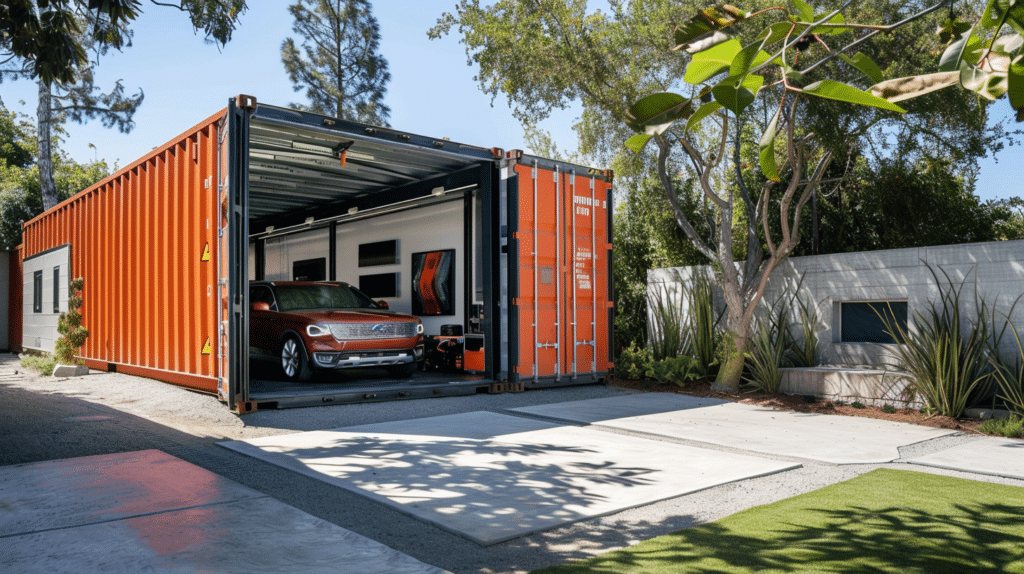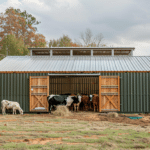Table of Contents
ToggleA Comprehensive Guide to Converting a Shipping Container into a Garage
In recent years, repurposing shipping containers has gained immense popularity due to their durability, versatility, and sustainability. One of the most innovative uses of these containers is transforming them into garages. This article delves into the process of converting a shipping container into a garage, exploring various aspects such as benefits, style options, size considerations, materials, custom modifications, anchoring methods, and additional factors to consider.
Benefits of Using a Shipping Container as a Garage
- Durability: Shipping containers are constructed to withstand harsh conditions during transportation across oceans, making them highly durable structures.
- Cost-Effectiveness: Compared to traditional construction methods, repurposing a shipping container as a garage can be more cost-effective, especially for those on a budget.
- Mobility: Shipping containers are inherently portable, allowing for easy relocation if necessary.
- Eco-Friendly: By repurposing a shipping container, you contribute to reducing waste and environmental impact, making it a sustainable choice.
- Quick Installation: Converting a shipping container into a garage typically involves minimal construction time compared to building a traditional garage from scratch.
Style Options
When it comes to styling your shipping container garage, there are several options to consider:
- Minimalist: Maintain the original industrial look of the shipping container for a modern and minimalist aesthetic.
- Rustic: Embrace the weathered appearance of the container for a rustic charm, perhaps by leaving some sections unpainted.
- Contemporary: Apply sleek finishes and modern design elements to achieve a contemporary look.
- Customized: Incorporate personalized touches such as decorative cladding, windows, doors, or a roof extension to match your preferences.
Size Considerations
Shipping containers come in various sizes, typically ranging from 10 to 40 feet in length. When selecting the size for your garage, consider factors such as:
- Vehicle Size: Ensure the container is large enough to accommodate your vehicles comfortably.
- Storage Needs: Allocate space for additional storage or work areas if required.
- Available Space: Take into account the available space on your property and any zoning regulations that may dictate size limitations.
Size Examples
- Compact Cars (e.g., Toyota Corolla, Honda Civic):
- Recommended Container Size: 20-foot container
- This size offers sufficient space for a single compact car along with some additional storage or workspace if desired.
- Midsize Cars (e.g., Toyota Camry, Honda Accord):
- Recommended Container Size: 20-foot container or 40-foot container
- A 20-foot container can accommodate a midsize car comfortably, while a 40-foot container provides extra space for storage, tools, or a workbench.
- SUVs and Trucks (e.g., Ford Explorer, Chevrolet Silverado):
- Recommended Container Size: 40-foot container
- SUVs and trucks typically require more space due to their larger dimensions. A 40-foot container offers ample room for one SUV or truck, as well as additional storage or workshop space.
- Sports Cars and Luxury Vehicles (e.g., Porsche 911, BMW 5 Series):
- Recommended Container Size: 20-foot container
- While sports cars and luxury vehicles may have lower ground clearance and require less space, a 20-foot container provides adequate protection and storage for these prized possessions.
- Classic Cars and Vintage Vehicles:
- Recommended Container Size: 20-foot container
- Classic cars and vintage vehicles are often smaller in size and can fit comfortably within a standard 20-foot container, offering protection from the elements and potential theft.
It’s important to note that these recommendations are approximate, and the actual size required may vary based on individual vehicle dimensions, additional storage needs, and personal preferences. Additionally, modifications such as adding shelving or storage racks inside the container can affect the available space. Before making a decision, it’s advisable to measure the dimensions of your vehicle and carefully consider any additional requirements.
Materials
Choosing the right materials is crucial for ensuring the longevity and functionality of your shipping container garage. Key considerations include:
- Insulation: Proper insulation is essential to regulate temperature and prevent condensation within the container.
- Ventilation: Install ventilation systems to maintain air circulation and prevent moisture buildup.
- Flooring: Consider durable flooring options such as concrete or epoxy coatings that can withstand heavy vehicle traffic.
- Exterior Finishes: Opt for weather-resistant paints or coatings to protect the container from corrosion and extend its lifespan.
Custom Modifications
Custom modifications allow you to tailor your shipping container garage to suit your specific needs and preferences. Some popular modifications include:
- Windows and Doors: Incorporate windows and roll-up doors for natural light, ventilation, and easy access.
- Electrical Wiring: Install electrical wiring and outlets for lighting, power tools, and other electrical appliances.
- Shelving and Storage: Add built-in shelving, cabinets, or storage racks to maximize organization and space utilization.
- Roof Extension: Extend the roof to create a covered outdoor area or additional storage space.
Anchoring Methods
To ensure stability and safety, proper anchoring is essential when installing a shipping container garage. Common anchoring methods include:
- Concrete Footings: Pour concrete footings and secure the container with anchor bolts or welded brackets.
- Ground Anchors: Utilize ground anchors or earth augers to secure the container to the ground.
- Concrete Slab: Pour a concrete slab foundation and weld the container directly onto the slab for added stability.
- Shipping Container Foundation: Construct a reinforced concrete foundation designed specifically for supporting shipping containers.
Additional Factors to Consider
- Permits and Regulations: Check local building codes and regulations to ensure compliance before starting the conversion process.
- Site Preparation: Prepare the site by leveling the ground and clearing any obstacles before delivery and installation.
- Maintenance: Regular maintenance, including inspection for rust or corrosion, is necessary to prolong the lifespan of your shipping container garage.
- Security: Consider installing security features such as locks, alarms, or surveillance cameras to protect your vehicles and belongings.
Transforming a shipping container into a garage offers a plethora of benefits, including durability, cost-effectiveness, and sustainability. By carefully considering style options, size requirements, materials, custom modifications, anchoring methods, and additional factors, you can create a functional and stylish garage that meets your needs and enhances your property. Whether you’re looking for a practical storage solution or a unique architectural statement, a shipping container garage provides a versatile and innovative solution.






